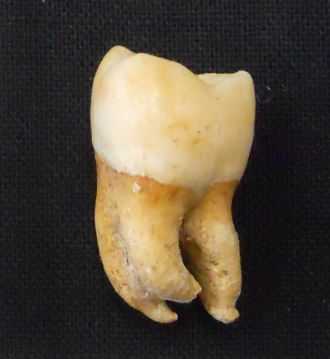
DAVIS, Calif. — A report from the University of California’s Davis campus has announced the discovery that the biological sex of human remains unearthed during archaeological digs can be determined from a protein study of a single tooth.
“Estimating the sex of human remains is important for archaeologists who want to understand ancient societies and peoples,” the university explains.
It notes that oftentimes “[r]esearchers can measure features of bones that differ between males and females, usually the pelvis.” However, these structural pelvic differences don’t appear in children and adolescents, and some digs may only result in a few pieces of bone.
While bones may not always provide answers, teeth preserve well throughout the ages and carry information about the individual’s life, including their ancestry, diet, and approximately how long ago the person lived. They can also tell researchers whether the person of the past was a male or female via the use of mass spectrometry.
“Amelogenin proteins play a role in the formation of tooth enamel,” the university outlines. “The genes for amelogenins happen to be located on the X and Y chromosomes that determine biological sex in humans, although amelogenin has nothing to do with this. Forensic DNA analyses for sex often depend on looking for the amelogenin X or Y genes.”
“Females will have amelogenin-X in their teeth; males should have both the X and Y versions of the protein,” it notes. “A positive result for amelogenin-Y means the tooth must have come from an XY male.”
While sometimes researchers can obtain a false negative for amelogenin-Y if the amount present is too little to be detected, a statistical method was created to ascertain the probability of a false negative based on the amount of amelogenin-X.
“While samples with AMELY_HUMAN peptides are unambiguously male, samples with no AMELY_HUMAN signal may either be low signal male false negative samples or female samples,” an abstract of the report, published in the Journal of Archaeological Science, expounds. “In order to estimate sex in these samples we developed a probability curve of female sex as a function of the logarithm of AMELX_HUMAN signal (p < 0.0001) using logistic regression.”
Researchers behind the study include Glendon Parker, associate adjunct professor of environmental toxicology; Julia Yip, a Davis student studying forensic sciences; Brett Phinney of the university’s Proteomics Core facility; and anthropologist Jelmer Eerkens.
Yip analyzed 40 tooth enamel samples from the remains of 25 people, both adults and children, spanning from hundreds to thousands of years old. As stated, all the teeth had amelogenin-X present, but approximately half of the samples were positive for amelogenin-Y, meaning that those particular teeth belonged to a male, while the rest were likely female.
“While the signal of each gene product can vary by more than an order of magnitude, we show close agreement between osteological and amelogenin-based sex estimation and thus demonstrate that the protein-based signal can be obtained reliably from open-air archaeological contexts,” the abstract outlines.
Although the biological sex of a person can also be determined through DNA, Eerkens said that the mass spectrometry method costs less than DNA analysis and can be conducted in an environment that is non-sterile.
Read the UC Davis post in full here and the report here.
In Mark 10:6, Jesus noted, “But from the beginning of the creation, God made them male and female.”
Become a Christian News Network Supporter...


